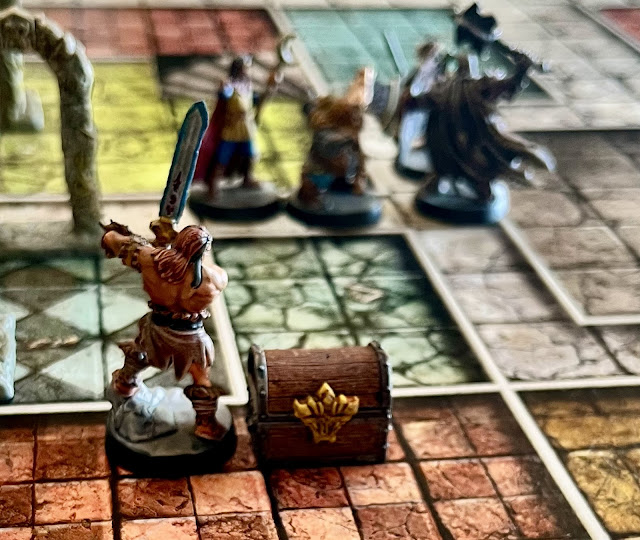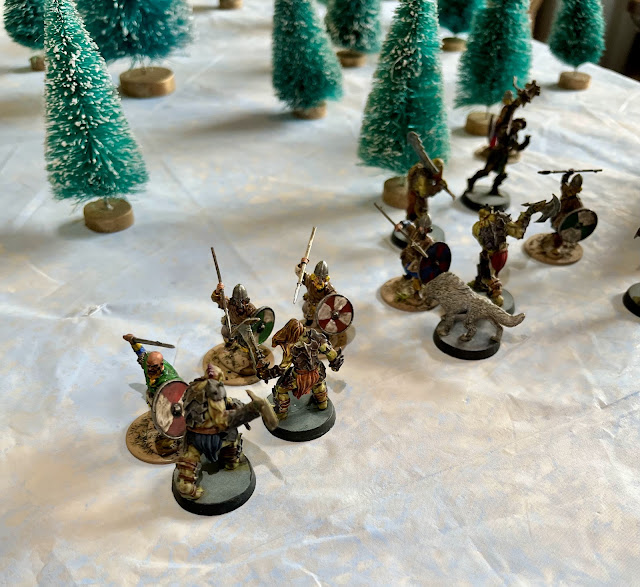Today, i am doing something very different. One of the things I love about Heroquest is that you can be very creative with the system. It can easily be re-skinned or home-brewed into a wide variety of games. Today, I am going to try to re-skin it as a Warhammer 40K Inquisitor game. Let's see how it goes!
It has been awhile since we tuned into to see what our Throne Agents were doing in Operation: Hemlock. Last we saw them, the Throne Agents had discovered a link between the Adaconite Smugglers and the Red Tower of Ammoriss. they had infiltrated an Adeptus Mechanicus facility and inserted a data-demon into their system. This began sending them intel.
Father Robertus was able to sort through the data and began to put together links. He quickly uncovered unusual activity being routed through a Guild House located in the Deff Islands, possibly as a clearing house. From there, Sebastian Twist was sent ahead aboard an Imperial supply vessel. The region was an active warzone, but the Imperial forces had a clear hold on Grig's Isle. Fighting was still raging on Baron's Rest, and the Ork control Zone was simply known as "The Green Zone".
Thankfully, the Guild House was on Grig's Isle near the Davros Mineworks. Most of these outfits were "wild cat" and independent operations that popped up, went bust, and crumbled; until those involved tried again. The Deff Islands was one of the rare sources of Adaconite that was not directly under the control of the Red Tower.
Sebastian was able to establish himself with the gangs and other ne'er-do-wells quickly and easily. They were his kind of people. The local underworld had mostly coalesced into an organization known as The Syndicate that was nominally allied with the Imperial war-effort. It did not take long for Twist to have his own operatives infiltrate the Guild Hall.
Twist was joined on Grig's Isle by the rest of the team later. However, at the safehouse they also found that the Inquisitor had provided a new asset in the form of a Combat Servitor. That could prove useful. Shortly after the Throne Agents set-up shop; Twist lost contact with his agents within the Guild Hall. They had hinted to Twist that they had found critical intel before contact was lost.
Sgt Major Bathory decided that if they did not act quickly, their operation could be compromised. The Throne Agents quickly assembled to raid the Guild Hall and retrieve the operatives.
Forces:
First off, I have decided to use my Heroquest Core set to play this game. It maybe a bit of a stretch, but it feels like the Heroquest board will be a great way to simulate the interior of a Guild Hall building. I plan on running the initial First Light scenario using the App, with a few modifications to the game rules that I will detail a bit later:
Sgt. Major Bathory
- Dwarf- Crossbow
I figured the best way to represent the skills of the Veteran Guardsman was using the Dwarf card armed with a crossbow in addition to the normal load-out.
Father Robertus
- Wandering Monk
This seemed like the best way to flavor an Imperial Drill Abbot with the 4 elements representing the Imperial Faith.
Sebastian Twist
- Rogue Heir of Elethorn
The Heirs ability to move through enemies seemed like natural fit for a spy like Twist. Plus, the thrown dagger matches his fighting style.
Codename: Gladius
- Barbarian with Broadsword
As a Combat servitor, the Barbarian card seemed like the closest fit.
 |
| From left to right: Sgt Major Bathory, Sebastian Twist, Father Robertus, and Gladius |
The only real upgrade is for the Dwarf to get a Crossbow, still leaving these guys as mostly "starting" Heroes. Therefore, the first scenario in the
First Light campaign could still be an issue.
Set-up
I will be using the base Heroquest rules and re-flavoring for the setting a bit. I will be making the following replacements and adjustments:
Goblins = Scavvies
Orcs= Gangers
Abominations= Gang Leaders
Dread Warriors= Skitarri
Dread Sorceror = Psyker
Gargoyle= Big Mutie
In addition, I am going to be using the Missile weapon rules for this game. However, ALL enemy models will have a ranged attack equal to half of their normal attacks rounded down. Therefore, a Scavvie has 1 ranged attack dice. A Gang Leader has 1, but Skitarri have 2. There are no missile troops in the
First Light scenario but if encountered they would act as normal. Therefore, in many situations it is still better to get up close and personal, Heroquest style. However, some situations may dictate otherwise.
No one can shoot at an enemy that is in base-to-base with an ally. That includes models that are in adjacent/diagonal squares to a friendly model. They also still use line-of-sight as if casting a spell to fire.
I have also decided that Heroes have a shoot ability of their normal attack divided by 2 rounding up:
1-3= 1
3-5= 2
6+= 3
Again, normal line-of-sight applies and Heroes can not use ranged attacks on enemy models that are in base-to-base with a friendly, even in adjacent/diagonal squares. However, the Combat Servitor will never shoot.
Mission
I am using the first Scenario from the
First Light supplement for this scenario. I will use the App to run the game for exploration, terrain, and enemy location; but run enemies with the shooting rules above
The Throne Agents are attempting to locate the 4 spies they had placed in the Guild Hall to gather their intel. They are going to be able to engage with a free hand, and are authorized to kill anyone who tries to oppose them.
The Game:
The Throne Agents quickly blast open the gate and storm the Guild House. The Combat Servitor mindlessly leads the way, and quickly locks in on an enemy Mutant. He easily rushes it and slashes it down before it can even react!
However, the Agents are in for a surprise as a booby-trap detonates and blocks them inside the Guild Hall. There is no easy ex-fil from where they came. All ready the plan has gone sideways.
Undeterred, they continue their sweep of the Guild House. However, they quickly discover they were too late. They discovered one of their informants dead, a scavvy and a ganger looking over his body their pistol's still smoking. Bathory makes short work of one, while Father Robertus deals with the other. Twist manages to get to the body and finds a small data-slate that is encrypted on the corpse. Perhaps it is the puzzle pieces they were looking for?
Gladius blasts down the next door with a powerful shoulder and barges into through the stronghold. He and Robertus lead the way. However, the Priest gets bogged down with a tentacled mutant while the others move ahead, seeping the Guild Hall.
It isn't long before an alarm bellows out, and Gangers and Scavvies from other parts of the Guild Hall head their way. Eventually, Father Robertus finishes his man but is pretty banged up. Thankfully, the crew came prepared with some Med-Kits, which he uses to patch himself up with.
The Sgt Major leads the team deep into the Guild Hall, where they find a pair of Gang Leaders. They were interrogating one of the spies but apparently executed him when the alarm went off. The team was too slow.
It is a tough fight, but eventually Father Robertus uses the Word of the Emperor to finish the last gang leader decisively. His faith is powerful enough to crush the muscled thug's skull with his Drill Abbot's Hammer.
They quickly find the Guild Houses main office, and it is heavily guarded by Gangers. Inside, a powerful Combat Servitor of their own is ready. Gladius rises to the challenge and charges into the battle. The presence of such a beast further confirmed the involvement of the Red Tower of Ammoriss with these smugglers. Twist managed to infiltrate the room as the battle raged and fired into the Combat Servitor's skull execution style from behind besting the beast.
The Throne Agents managed to sweep the rest of the Guild House clean. Even their secret chambers were discovered. The agents they were sent to locate were all dead. Just as Sgt. Major Bathory feared. However, they got there in time to secure incriminating data-slates, physical records and even some local script and golden Thrones currency.
Like all rat's nests, this one had a secret back entrance that the rat's had used to escape. The Throne Agents uncovered it and made their way out as well. The ex-filtrated back to their safehouse to debrief, rifle through their new leads, and to tend to their injuries.
Final Thoughts
That worked out just fine. I recently watched a play through of this mission that ended in a TPK. I did not have that same level of difficulty at all. My Monk got beat-up but the bonus Medical Kits provided by the Inquisitor (Healing Potions from Sir Ragnar) smoothed over the worst of it. I did get pretty lucky on Treasure cards though, only 1 Wandering Monster and 1 Hazard!
My Monk needed it after getting caught flat-footed by opponents at the end of the Heroes' turn cycle a few times. Otherwise, the rest only took a point of damage here and there, but nothing life threatening. This games MVP was Gladius the Combat Servitor as he rampaged through Scavvies and Gangers with ease!
The group ended with a haul of 580 Golden Thrones, 2 Med-Kits (Potion of Healing), a gem worth 35, a one-use Refractor Field (Potion of Defense), and a Psyker's Brass Staff (Wizard's Staff).
Overall, I think that worked pretty well! The shooting rules and such were not even needed. Most of the time, the fights were close enough where shooting was not the better option. The only one that shot much was Sgt. Major Bathory and a Scavvy once or twice. Most of the time, the enemies/Heroes were within 1 square of a friendly anyway so you couldn't get a clean shot.
I will have to take a look and how I can re-fluff the rest of First Light for my throne agents to keep on playing it.
Until next time.
Become a Patron and get access to all the cool stuff, a peak behind the curtain of Blood and Spectacles, and early-access to playtest games!
Check out the latest publications and contact me at our
Blood and Spectacles website





































